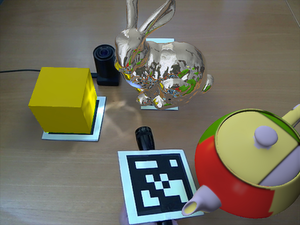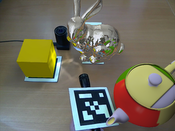Information
- Publication Type: Journal Paper with Conference Talk
- Workgroup(s)/Project(s):
- Date: March 2013
- Journal: IEEE Transactions on Visualization and Computer Graphics (Proceedings of IEEE VR 2013)
- Volume: 19
- Number: 4
- Location: Orlando, Florida
- Lecturer: Martin Knecht
- ISSN: 1077-2626
- Event: IEEE Virtual Reality 2013
- Conference date: 18. March 2013 – 20. March 2013
- Pages: 576 – 582
- Keywords: Mixed Reality, Caustics, Reflections, Refractions
Abstract
In this paper, we present a novel rendering method which integrates reflective or refractive objects into a differential instant radiosity (DIR) framework usable for mixed-reality (MR) applications. This kind of objects are very special from the light interaction point of view, as they reflect and refract incident rays. Therefore they may cause high-frequency lighting effects known as caustics. Using instant-radiosity (IR) methods to approximate these high-frequency lighting effects would require a large amount of virtual point lights (VPLs) and is therefore not desirable due to real-time constraints. Instead, our approach combines differential instant radiosity with three other methods. One method handles more accurate reflections compared to simple cubemaps by using impostors. Another method is able to calculate two refractions in real-time, and the third method uses small quads to create caustic effects. Our proposed method replaces parts in light paths that belong to reflective or refractive objects using these three methods and thus tightly integrates into DIR. In contrast to previous methods which introduce reflective or refractive objects into MR scenarios, our method produces caustics that also emit additional indirect light. The method runs at real-time frame rates, and the results show that reflective and refractive objects with caustics improve the overall impression for MR scenarios.Additional Files and Images
Weblinks
BibTeX
@article{knecht_martin_2013_ReflRefrObjsMR,
title = "Reflective and Refractive Objects for Mixed Reality",
author = "Martin Knecht and Christoph Traxler and Christoph Winklhofer
and Michael Wimmer",
year = "2013",
abstract = "In this paper, we present a novel rendering method which
integrates reflective or refractive objects into a
differential instant radiosity (DIR) framework usable for
mixed-reality (MR) applications. This kind of objects are
very special from the light interaction point of view, as
they reflect and refract incident rays. Therefore they may
cause high-frequency lighting effects known as caustics.
Using instant-radiosity (IR) methods to approximate these
high-frequency lighting effects would require a large amount
of virtual point lights (VPLs) and is therefore not
desirable due to real-time constraints. Instead, our
approach combines differential instant radiosity with three
other methods. One method handles more accurate reflections
compared to simple cubemaps by using impostors. Another
method is able to calculate two refractions in real-time,
and the third method uses small quads to create caustic
effects. Our proposed method replaces parts in light paths
that belong to reflective or refractive objects using these
three methods and thus tightly integrates into DIR. In
contrast to previous methods which introduce reflective or
refractive objects into MR scenarios, our method produces
caustics that also emit additional indirect light. The
method runs at real-time frame rates, and the results show
that reflective and refractive objects with caustics improve
the overall impression for MR scenarios.",
month = mar,
journal = "IEEE Transactions on Visualization and Computer Graphics
(Proceedings of IEEE VR 2013)",
volume = "19",
number = "4",
issn = "1077-2626",
pages = "576--582",
keywords = "Mixed Reality, Caustics, Reflections, Refractions",
URL = "https://www.cg.tuwien.ac.at/research/publications/2013/knecht_martin_2013_ReflRefrObjsMR/",
}


